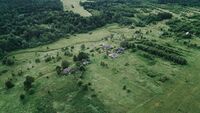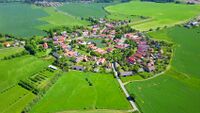Kozato
Kozato (こざと, JapanBeta) is set of the following three Unicode characters:
Each of characters kozato can be pronounced "Kozato" or "Oozato" or "kozatohen" and refer to a geographic place, village, country, city, hill, community [4]
Phonetic and semantic
Character X961D 阝 seems to be more popular, than X2ECF ⻏ and X2ED6 ⻖; pronunciation Kozato and semantic (village, place) of X961D 阝 [5][6] is attributed to all Kozato characters.
Characters Kozato look similar and cause confusion. Word Kozato can be used as the recognizable substitute.
In the vulgar interpretation, term Kozato can be considered as Romanji writing of sound of each of the three characters. However, just for the sound, the Hiragana writing こざと seems to be more suitable.
Graphic
Characters Kozato look very similar (at Macintosh, they look the same). This is typical for Japanese characters, while the computer support of Japanese language is still underdeveloped.
Up to year 2021, yet, there is no united standard of the default font for Japanese characters, that would allow each character to look the same at various computers, but different from other characters. Such a font would allow to give different meaning to the Kozato characters [7]. Yet, it is difficult to predict how long the graphic representation of characters Kozato will remain look similar.
While this fault is not fixed, term Kozato can be used instead of any of characters ⻏, ⻖, 阝; such a notation is expected to reduce amount of the confusions.
At least until year 2021, all the Kozato character look the same, similar to Greek letter \(\beta\). This similarity is used for the alternative, pictorial name JapanBeta that means the same as Kozato.
Synonyms
Warning
Meaning of kanjis in TORI is constructed based on the descriptions in the dictionaries cited. This is first approach, necessary to establish nomenclature of Japanese characters. It is necessary to reveal the confusions, as some characters happen to look very similar; the confusions disturb preparation and analysis of texts in Japanese; so, this part of job should be done first.
The second approach should include the analysis of the practical of use of the characters in applied (not related to learning of Japanese) texts. Then, the semantic can be adjusted.
References
- ↑ https://util.unicode.org/UnicodeJsps/character.jsp?a=2ECF ⻏ 2ECF CJK RADICAL CITY Han Script id: allowed confuse: ⻖ , 阝 ..
- ↑ https://util.unicode.org/UnicodeJsps/character.jsp?a=2ED6 ⻖ 2ED6 CJK RADICAL MOUND TWO Han Script id: allowed confuse: 阝 , ⻏ ..
- ↑ https://util.unicode.org/UnicodeJsps/character.jsp?a=961D 阝 961D CJK UNIFIED IDEOGRAPH-961D Han Script id: restricted confuse: ⻖ , ⻏
- ↑ 4.0 4.1 4.2 https://kanjialive.com/214-traditional-kanji-radicals/ The 214 traditional kanji radicals and their variants .. ⻏ .. village, country, city おおざと a variant of ⾢(むら) Important .. ⻖ .. hill, mound こざとへん a variant of ⾩(こざと) Important ..
- ↑ https://jisho.org/search/%23kanji%20阝 阝 3 strokes Radical: mound, dam (阝 left) 阜 (阝) Parts: place, left village radical - 2 stroke form (no. 170) Kun: こざと
- ↑ https://nihongomaster.com/japanese/dictionary/kanji/11467/阝 阝 3 Strokes Definition of 阝 place left village radical - 2 stroke form (no. 170) Readings On'Yomi (音読み) Kun'yomi (訓読み) こざと
- ↑ Giving different pictures to the Kazato characters could make Japanese more informative. For example, character X2ECF ⻏ could mean a small village, character X2ED6 ⻖ cold mean an intermediate village, and character X961D 阝 could be used to indicate a big village or a small town.


